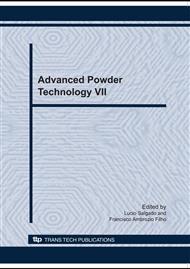p.837
p.844
p.848
p.854
p.860
p.866
p.873
p.879
p.885
Use of Eucalyptus Firewood Ash into Clayey Ceramic
Abstract:
This work aims at evaluating the incorporation of eucalyptus firewood ash into clayey ceramic, through the physical and mechanical properties of the produced ceramics. Mixtures of kaolinitic clay from the municipal area of Campos of Goytacazes, in the state of Rio de Janeiro, Brazil, were prepared with additions of 0, 5, 10 and 20% in weight of ashes from eucalyptus firewood. Specimens were 20 MPa uniaxially press-molded and fired at 900°C. The evaluated firing properties were diametrical shrinkage, water absorption and mechanical strength by diametrical compression. The results showed that the incorporation of 10% wt. of firewood ash enhanced the properties of the clayey ceramic and since plasticity was optimised, water absorption decreased while the mechanical strength increased.
Info:
Periodical:
Pages:
860-865
Citation:
Online since:
October 2010
Keywords:
Price:
Сopyright:
© 2010 Trans Tech Publications Ltd. All Rights Reserved
Share:
Citation:


